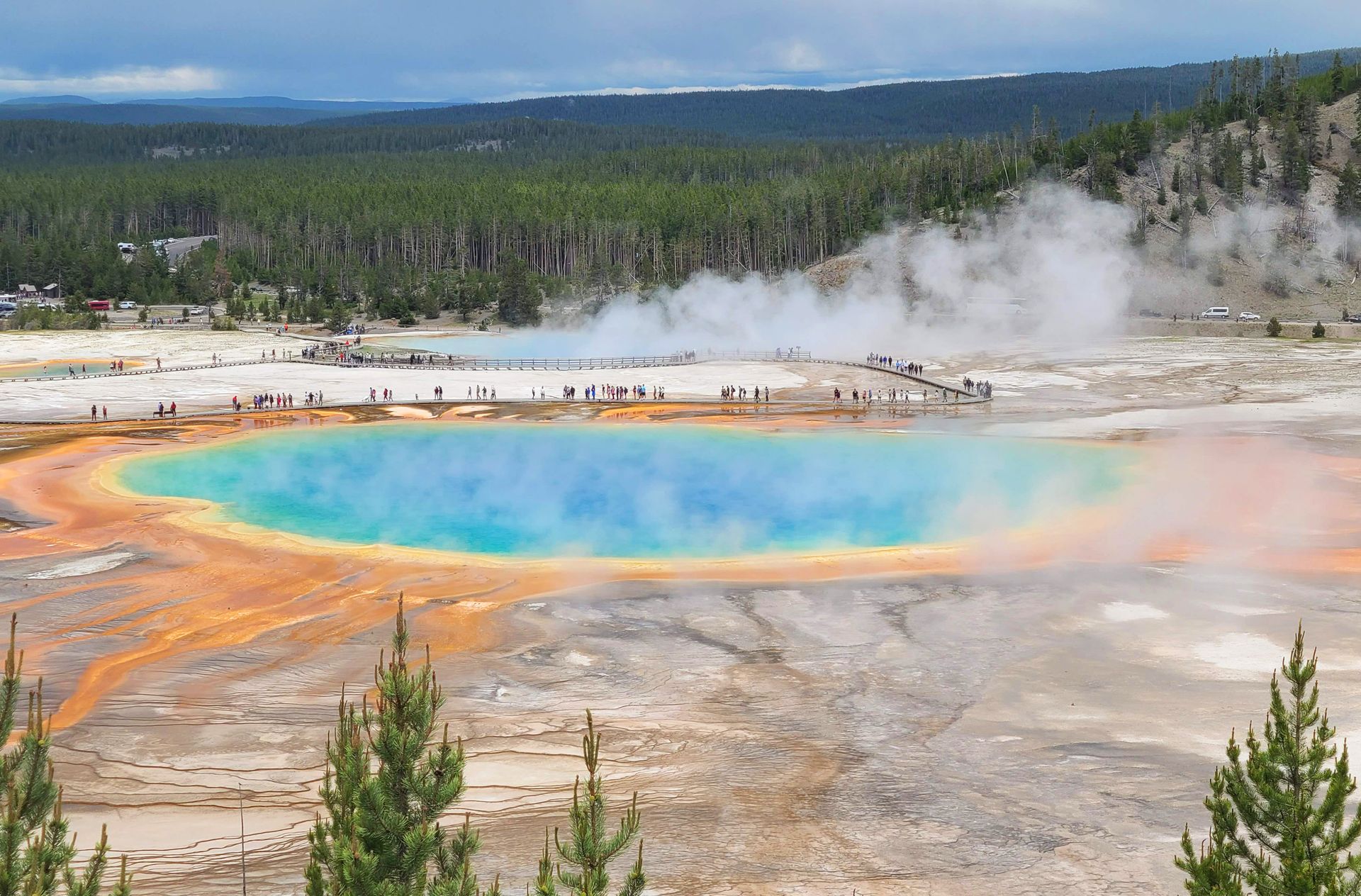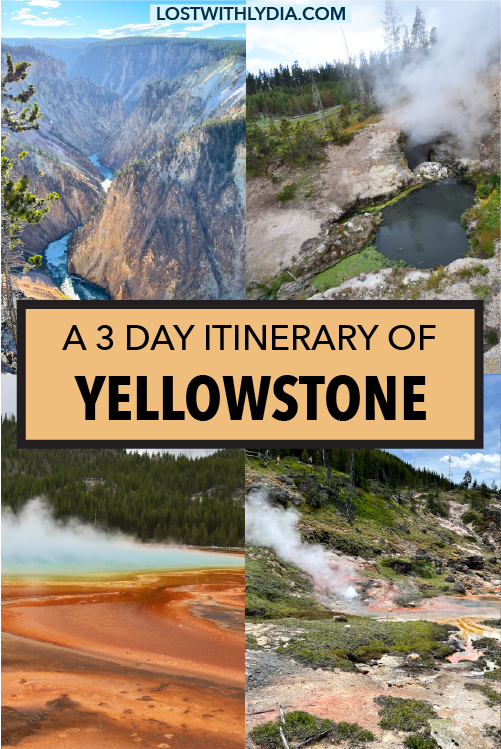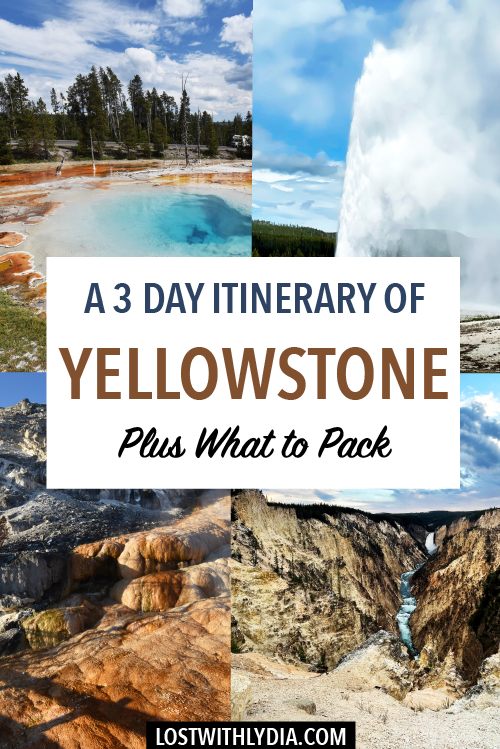Yellowstone was America’s first national park and you’ll quickly see why this area is worth protecting. It is full of bubbling hot springs, magnificent geysers, steaming fumaroles, huge canyons, a range of wildlife and so much more. Discover all of the best things to do in Yellowstone in this 3 day itinerary!
The park is one of the most visited in the United States despite its remote location. It spans 3,472 square miles across three states. The park’s location atop one of the few supervolcanoes in the United States causes colorful hot springs, sputtering geysers, changing water levels in Yellowstone Lake, boiling mud and other thermal activity.
Yellowstone is home to over half of the world’s geysers!
This guide shares the best way to spend 3 days in Yellowstone, with each night in a different park lodge. If you plan to stay inside of the park, book your stay several months to a year in advance so you can get the rooms you want.
This post is based on my experience visiting Yellowstone in 2021, but has been updated for visiting in 2025.

Please make it a priority to Leave No Trace when exploring the outdoors. This includes leaving nothing behind, respecting wildlife, minimizing campfire impacts, respecting those around you, planning ahead and traveling on durable surfaces. For more details, read about the seven principles at lnt.org.
When To Visit Yellowstone
Yellowstone in the Spring (April - May)
During the spring in Yellowstone, you might be able to see wildlife emerging from winter hibernation. You’ll also experience much less crowds. However, the earlier the visit, the more likely that some roads will remain closed in the park due to snow.
Yellowstone in the Summer (June - August)
The summer months are arguably the best months time to visit Yellowstone. Everything will be open and you'll likely have nice weather. Of course, this is also the most crowded time of year. I visited in June and enjoyed great weather. It was crowded but I avoided some of the crowds in the early mornings and late nights.
Yellowstone in the Fall (September - October)
The fall months are similar to the spring; you’ll get to experience active wildlife with much fewer crowds. Note that it will get cold quickly in these months and seasonal road closures begin in mid-October. Some facilities also begin to close as early as mid-September.
Yellowstone in the Winter (November - March)
Most of the roads in the park are closed to regular cars in the winter months. However, the Mammoth Hot Springs Hotel remains open. You can also ride a snowcoach or snowmobile to the Old Faithful area and stay in the Snow Lodge during the winter months. You are able to explore the parts of the park via snowshoe or skis, making for a unique experience.
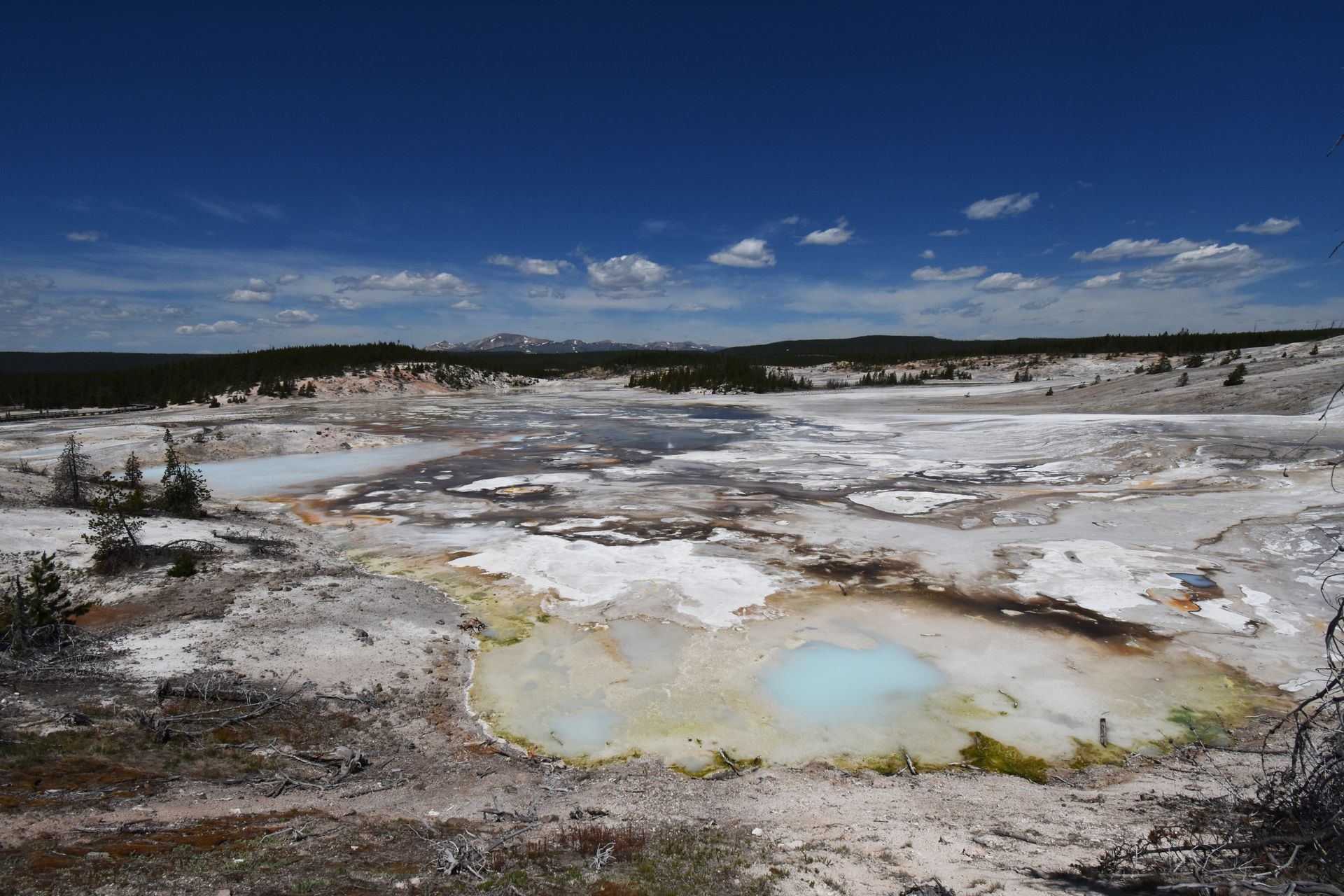
How to Get To Yellowstone National Park
There are five entrances to Yellowstone and multiple airport options to take you to different entry points.
- Bozeman Airport: Bozeman is an hour and a half away from the Northwest Entrance of the park (the entrance closest to Mammoth Hot Springs).
- Jackson Airport: Jackson is an hour away from the south entrance into the park.
- Idaho Falls Airport: This small airport is an hour and 45 minutes away from West Yellowstone.
- Salt Lake City Airport: Salt Lake City is located 4 hour and a half hours from the West Yellowstone entrance. While it is further away, the airport is much bigger and has a lot more options for car rentals.
This Yellowstone National Park itinerary begins from Bozeman and ends south of the park at Grand Teton National Park. After visiting Yellowstone, I spent a couple of days in Grand Teton and then flew out of the Jackson Airport. A split ticket flight and car rental can save you a lot of driving time!
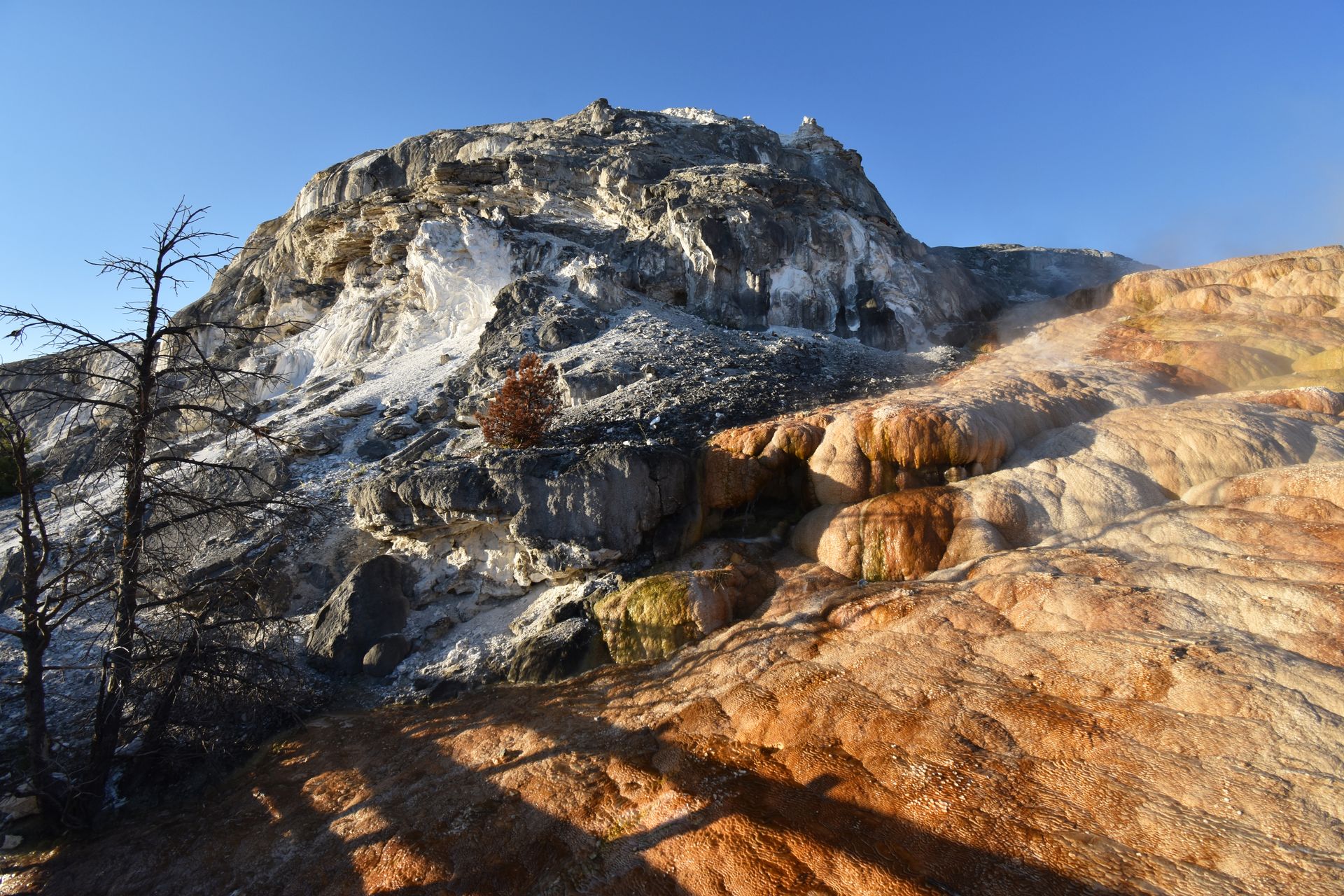
Tips for Visiting Yellowstone
Here are some of my top tips to enjoy a successful and fun Yellowstone road trip!
- Download the Guide Along app for an audio tour as you drive through the park.
- There are plenty of gas stations and general stores inside of the park. It is still a good idea to bring in your own food to save time, but you won’t be too far from anything you need.
- The cell service is spotty in most of the park. Be sure to download offline maps and/or carry a paper map with you.
- The roads inside of Yellowstone create a giant figure eight and there are no alternative routes outside of these main loops. You may experience traffic delays from wildlife on the roads.
- Arrive at popular destinations very early or late in the day to beat the crowds! It’s worth getting up early to enjoy the sunrise and the solitude.
- RV parking is not available in all of the parking lots in Yellowstone. If you’re visiting in an RV, be patient and aware that you may not be able to find parking at every stop.
Ready to book your trip? Check out my Yellowstone packing list
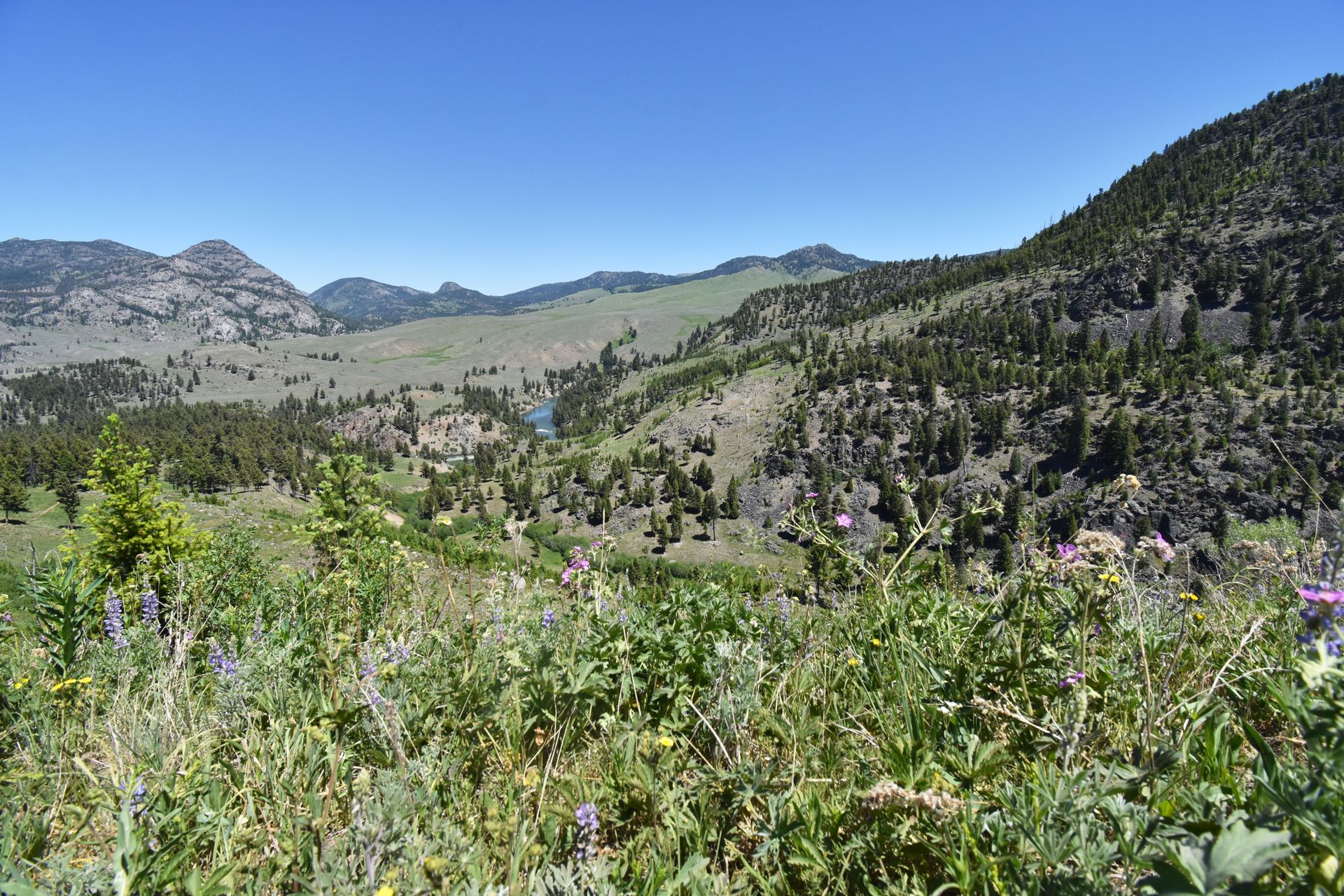
Things You Need to Know before Visiting Yellowstone
- The entry fee for Yellowstone is $35 per car for 7 days. If you’re visiting multiple national parks within the year, I recommend purchasing the America the Beautiful pass which is $80 and includes entry to all US National Parks.
- Be sure to give wildlife ample space in Yellowstone for your own safety as well as the safety of animals that live in the park. Do not approach any wildlife. The park recommends staying 100 yards away from bears and wolves and 25 yards from all other animals. Personally, I recommend staying at least 50 yards away from bison after witnessing a hiker be attacked by one at a Texas state park.
- When visiting thermal areas, always stay on the trail. Stepping into or touching a hot spring can severely burn you or even result in death. In addition, do not throw anything into a geyser, hot spring or any feature, it can permanently alter the feature’s chemistry.
- Please read the rest of the guidelines for visiting Yellowstone and take the Yellowstone Pledge on the national park’s website.

What to Pack When Visiting Yellowstone
- Bear spray. This is necessary if you’re hiking but not if you are only staying on the boardwalk trails. You cannot pack this if you’re flying, so you will need to purchase it upon arrival. It can be found at most grocery stores.
- Bug spray. The mosquitoes were bad in the Northern portion of the park, especially when hiking. I love Ranger Ready because it doesn't use DEET and smells better than typically bug spray.
- Sunscreen. Always important! A hat and sunglasses are also a good idea.
- A camera with a zoom lens. Yellowstone has incredible opportunities for wildlife photography if you’re interested.
- Binoculars. These will be helpful if you enjoy searching the valleys for wildlife in the distance.
- Layers. Yellowstone is located at a high elevation so it may be cold in the evenings and early mornings but quite hot in the middle of the day.
- Good walking or hiking shoes. Whether you’re staying on the boardwalks or doing serious hikes, it’s best to have closed toe, sturdy shoes to stay comfortable.
- A paper map. This is always helpful for navigating without cell service.
- Water and snacks. I purchased food for lunch outside of the park and had it with me. It saves a lot of time to be able to eat on the go rather than waiting in line at restaurants or general stores inside the park.
If you already have your Yellowstone lodging booked and are just looking for things to do inside the park, head over to my list of over 50 things to do and see inside the park.
Where to Stay When Visiting Yellowstone
This Yellowstone itinerary is based upon staying in a different park lodge for three nights in a row. Of course, you can still follow it no matter where you stay. But if you really want to maximize your time, switching lodges each night is the best way to do it!
I stayed at the Mammoth Hot Springs Inn, the Canyon Lodge and the Old Faithful Inn and I have documented my experience at each hotel in another blog post. If you want to stay inside the park, I recommend booking about a year in advance, but it’s always possible you’ll get lucky and be able to snag a spot a lot closer to your dates. (check back often for cancellations)
If you don’t want to or can’t stay inside the park, I would recommend staying in the town of Gardiner for the first night and the town of West Yellowstone for the next two nights. There are plenty of hotel options in both.
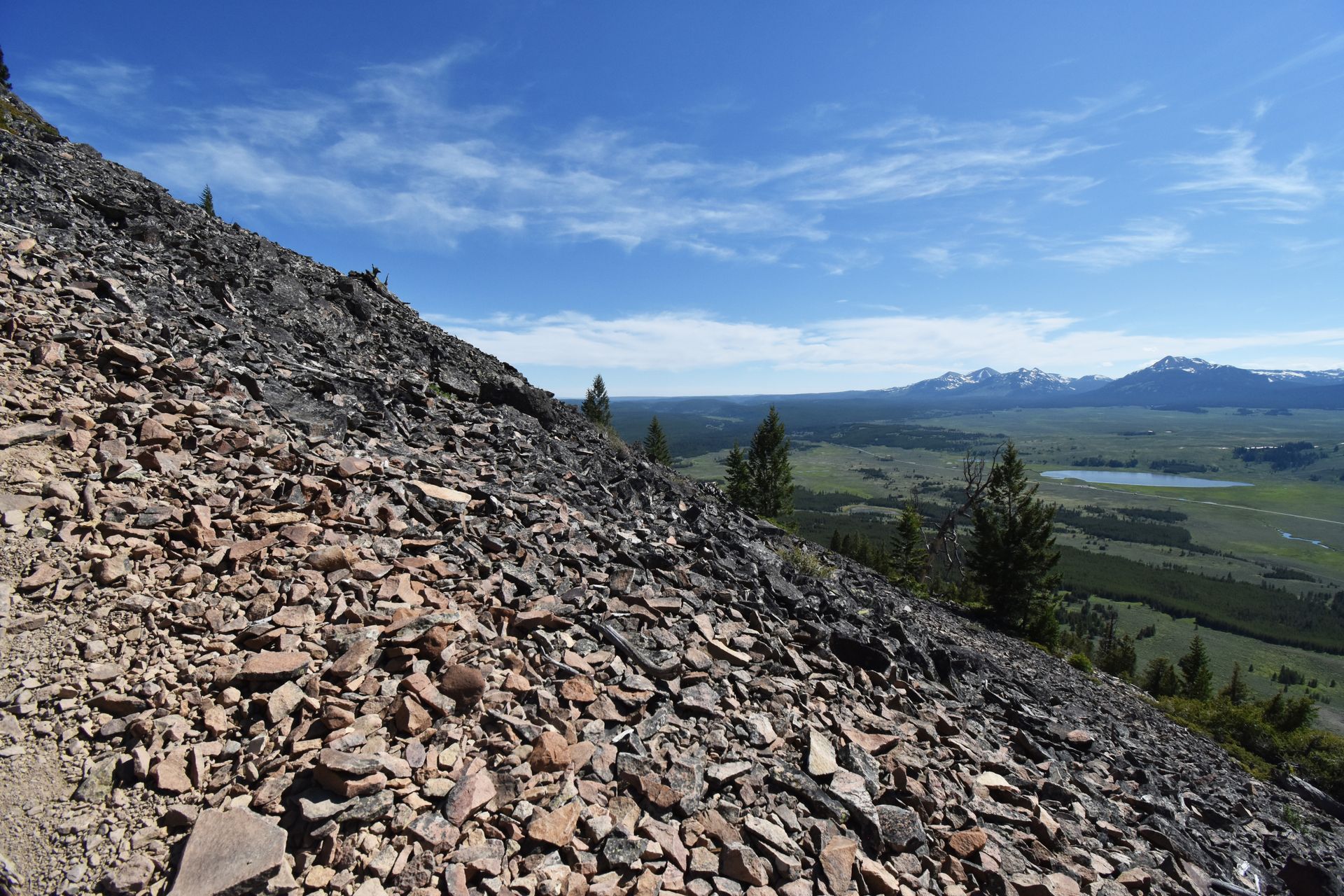
How Many Days Do You Need in Yellowstone?
This park is large and a bit spread out, so I recommend having more than one day in Yellowstone so that you can properly experience the best that the park has to offer! I think three days in Yellowstone is perfect to see all of the highlights and have some time to hike and/or look for wildlife.
I tend to be on the go sunrise to sunset, so if you prefer to take things slower, you may want to spend more time.
The Best Yellowstone 3 Day Itinerary
This is the best route to take when visiting Yellowstone (in my opinion)! This itinerary for Yellowstone begins from the north and exits from the south (I recommend visiting Grand Teton afterward). I've laid out an itinerary that will take you to the most popular places at sunrise and sunset so you can avoid the infamous Yellowstone crowds.
Day One in Yellowstone
Day one covers Lamar Valley and two hikes in the northern part of the park.
Fly into Bozeman
Begin your 3 day trip to Yellowstone by flying into Bozeman Yellowstone International Airport. All of the major airlines fly here and there are non-stop routes from many cities around the United States. I spent one night in Bozeman and purchased food and bear spray before heading into Yellowstone.
Roosevelt Arch
If roads allow, make a stop at the Roosevelt Arch, an iconic structure over the road at the park's North entrance. The arch stands 50 feet tall, was built in the early 1900’s and symbolizes a gateway to the national parks. Then, make your way east to the Lamar Valley. The beginning of Lamar Valley is a 45 minute drive from Roosevelt Arch.
Lamar Valley
Lamar Valley is a beautiful area in the Northeast area of the park known for its high concentration of wildlife. It is home to bison, bear, gray wolves, pronghorn, bald eagles and more. The wildlife is best seen at sunrise and sunset, but I still saw a lot a couple hours after sunrise. I saw six bears in this area of the park!
There are many viewpoints and pull offs during the drive. One interesting stop is the Soda Butte Cone, a striking cone shaped rock that ascends into the air next to the Soda Butte Creek.
As you drive through Lamar Valley, you’ll drive past mountain peaks, rivers and so much wildlife. To explore on foot, you can also hike the Lamar Valley Trail or the Slough Creek Trail. Even if you only have time for a quick drive through, this area is definitely worth your time.
Near the Roosevelt Lodge and right before entering Lamar Valley, there is a petrified tree a short walk from the parking lot. While this wasn’t the most exciting stop, I saw a bear (from a safe distance), right along the path!
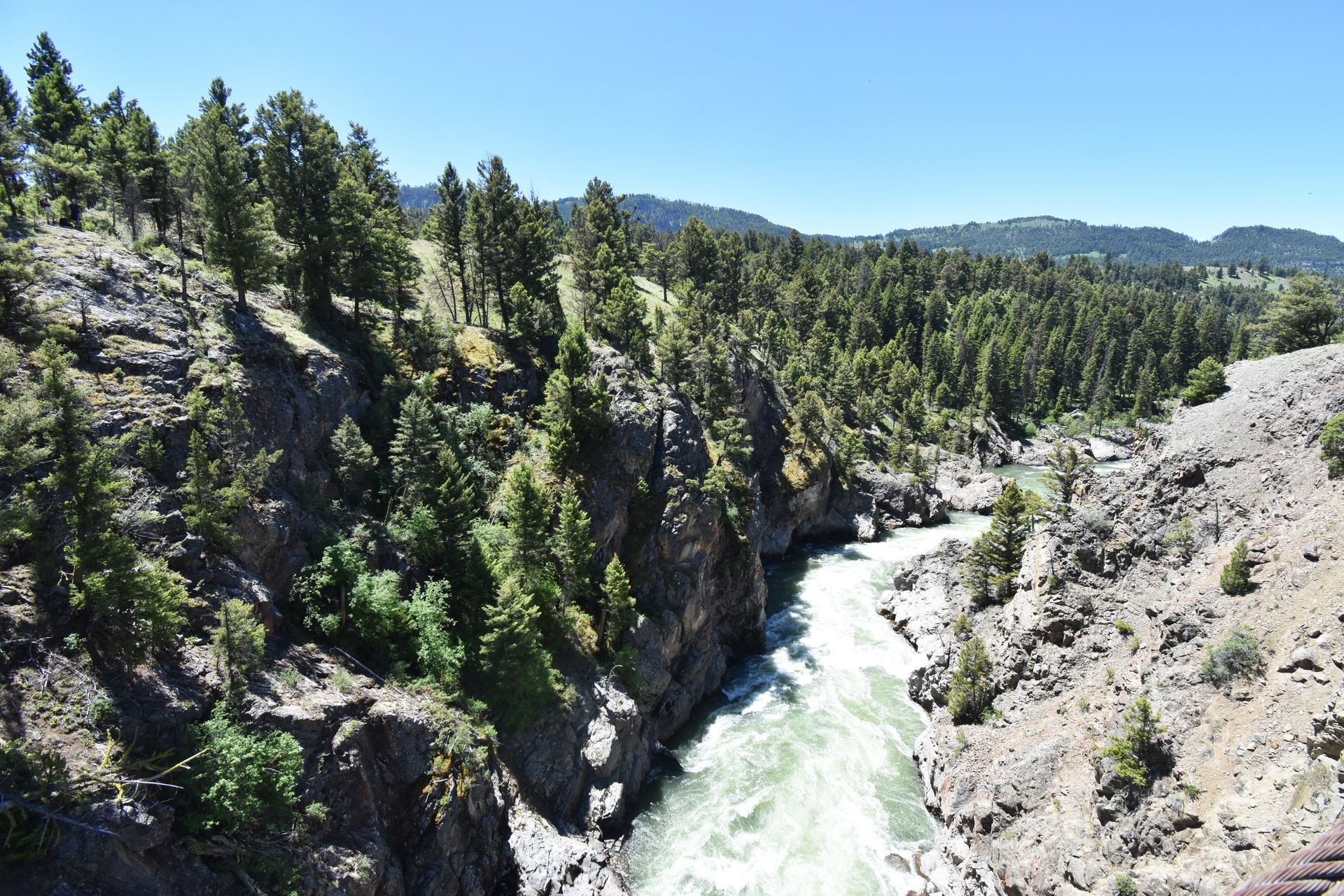
Hellroaring River Suspension Bridge Trail
After the scenic drive through Lamar, I hiked two trails near the Mammoth Springs Area. The first hike, to the Hellroaring Suspension Bridge, is 10 minutes from the beginning of Lamar Valley and 30 minutes from Mammoth Hot Springs.
The trail is a one mile descent of about 600 feet to reach the bridge. There are stunning views throughout the path of the Elk Creek in the valley down below. When I visited in June, there were beautiful wildflowers spread across the grass. When you reach the bridge, walk across and feel it shake in the wind and with the people traveling across. In a canyon below the bridge, the Yellowstone River rushes with power and gust.
You can also continue along this trail past the bridge, where it leads to several backcountry campsites. There were many mosquitoes and little cover on this trail, so be sure to bring bug spray and sunscreen. This hike was not too crowded, making it perfect for escaping the crowds and enjoying the natural beauty of the area.
If you are new to hiking, check out my tips for beginner hikers before exploring this trail!
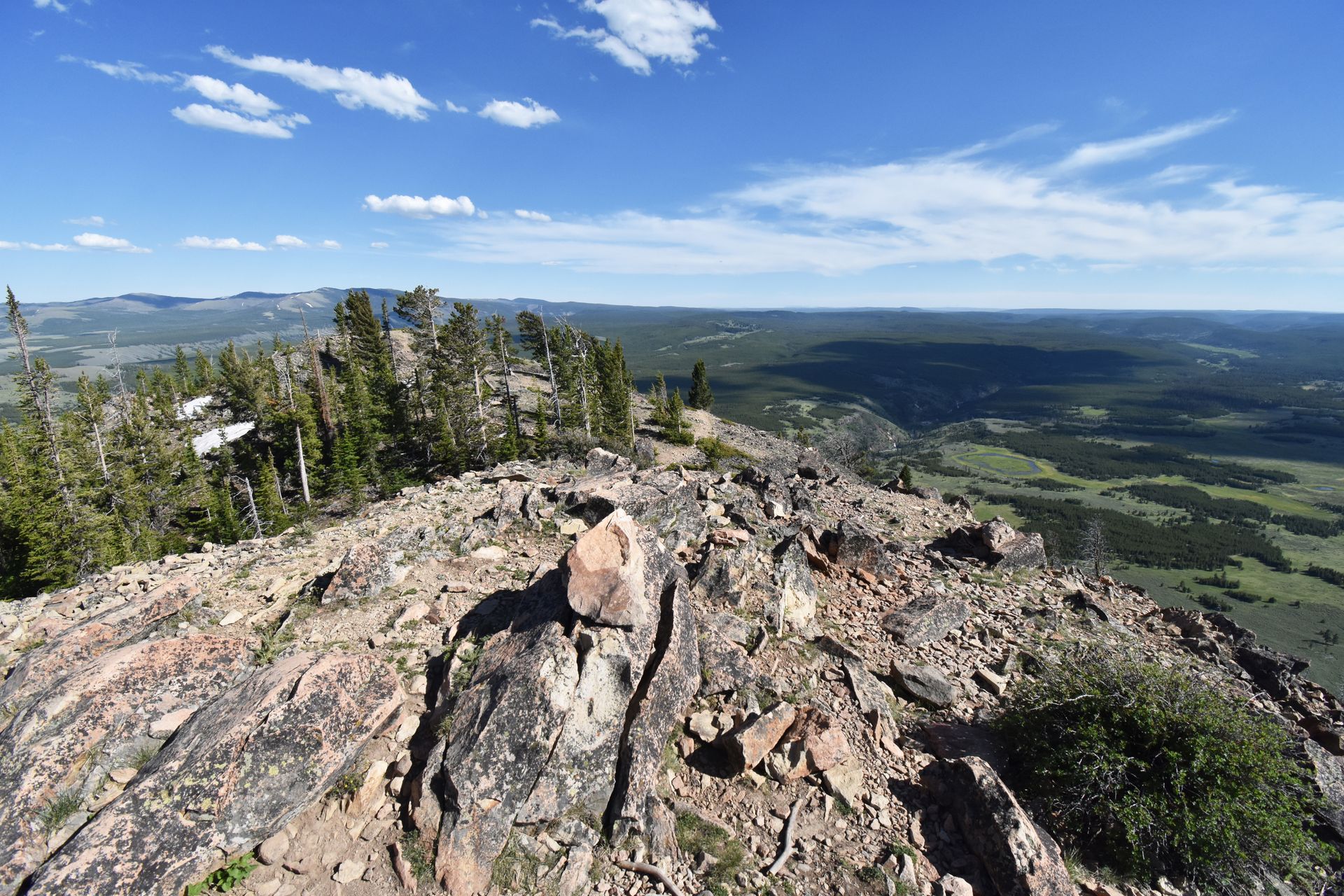
Bunsen Peak Trail
For the second hike, you will pass through the Mammoth Hot Springs area (catch a quick glimpse for later!) and then continue about 10 more minutes south. After a beautiful drive through the golden gate canyon, arrive at the trailhead for Bunsen Peak. (This trailhead has no bathroom and limited parking.)
Alternatives to Bunsen Peak: If you are not interested in another hike, explore the Mammoth Hot Springs area now! If you would like an even more strenuous hike, take the 9.9 mile hike to Osprey Falls.
The Bunsen Peak trail is 4.4 miles round trip and includes 1,282 feet of elevation gain. The trail has several switchbacks with beautiful views of the surrounding valley. You’ll get to see the Golden Gate Canyon and the impressive road running through it to the north. At the top of the trail, there is a small shed with a log book that you can sign. There is also a radio tower and electrical equipment. Despite all of the wires, Bunsen Peak has amazing views of the surrounding area.
There are a couple of instances towards the top of the trail where you are walking on loose rocks. But overall, there is no intense rock scrambling or steep drop offs.

Stay at Mammoth Hot Springs Hotel
After a day of hiking, check into the Mammoth Hot Springs Hotel for the night. There are two restaurants right across from the hotel. Mammoth Terrace Grill is a more casual option serving burgers, fries and ice cream, while the Mammoth Dining Room serves higher end meals like pasta and steak.
You’re likely to see elk roaming the yard and surrounding area at the Mammoth Hot Springs Hotel!
If you’re up for it, visit Mammoth Hot Springs around sunset! If not, save it for sunrise the next day. It’s beautiful to see the light reflecting off of the pools at sunrise or sunset.
If you can’t get a spot in the Mammoth Hot Springs Hotel, book a hotel in Gardiner for the night. It is only about 15 minutes away.

Day Two in Yellowstone
Day two covers Mammoth Hot Springs, Artist's Paintpots, Fountain Paintpots, Norris Geyser Basin and Mud Volcanoes.
Sunrise at Mammoth Hot Springs
The Mammoth Hot Springs Lower Terrace is an 8 minute walk from the Mammoth Hot Springs hotel. I visited first thing in the morning, and then went back to the Mammoth Terrace Grill for breakfast and to check-out of the hotel.
Mammoth Hot Springs is a unique feature made up of chalky white and yellow travertine terraces. These features can vary between seasons, so you never know exactly what you’ll see. Acidic water carves through limestone and creates terraces of white, chalky minerals.
There are two sections of the Mammoth Hot Springs. You can walk or drive between them, but will want your car to do the driving loop at the Upper Terrace. The lower terrace area has a boardwalk with some steps throughout. One notable feature is the Liberty Cap, a 37 foot tall hot spring cone that stands on its own.
The Upper Terrace of Mammoth Hot Springs includes a small parking area and a one way loop drive past several more features. Be sure to take a quick walk to see the impressive Orange Spring Mound, an accurately named feature of orange minerals built up into a cone. Then continue on the loop drive where you’ll pass a few more features and might spot some elk.
The sunrise light at Mammoth Hot Springs is so beautiful, the pools reflect off of the sun and seemingly glow in the light. There were also very few people at sunrise. I highly recommend visiting this gem in Yellowstone, especially at sunrise or sunset.
Quick stops at Sheepeater Cliff and Roaring Mountain
Sheepeater Rock and Roaring Mountain are a couple of quick stops to make between Mammoth Hot Springs and the Norris Geyser Basin if you have time.
Sheepeater Cliff is about 15 minutes down the road from Mammoth Hot Springs and is made of columnar basalt that was deposited by lava flows roughly 500,000 years ago. It’s a short drive from the Grand Loop Road. This also serves as a picnic area and the start of a trail along the Gardner River.
Located 15 minutes further down the Grand Loop Drive, Roaring Mountain is right off of the road. Here, steam flows from fumaroles off of a rockface. If you listen closely, you may hear a hissing noise, but the loudness can vary throughout the year.
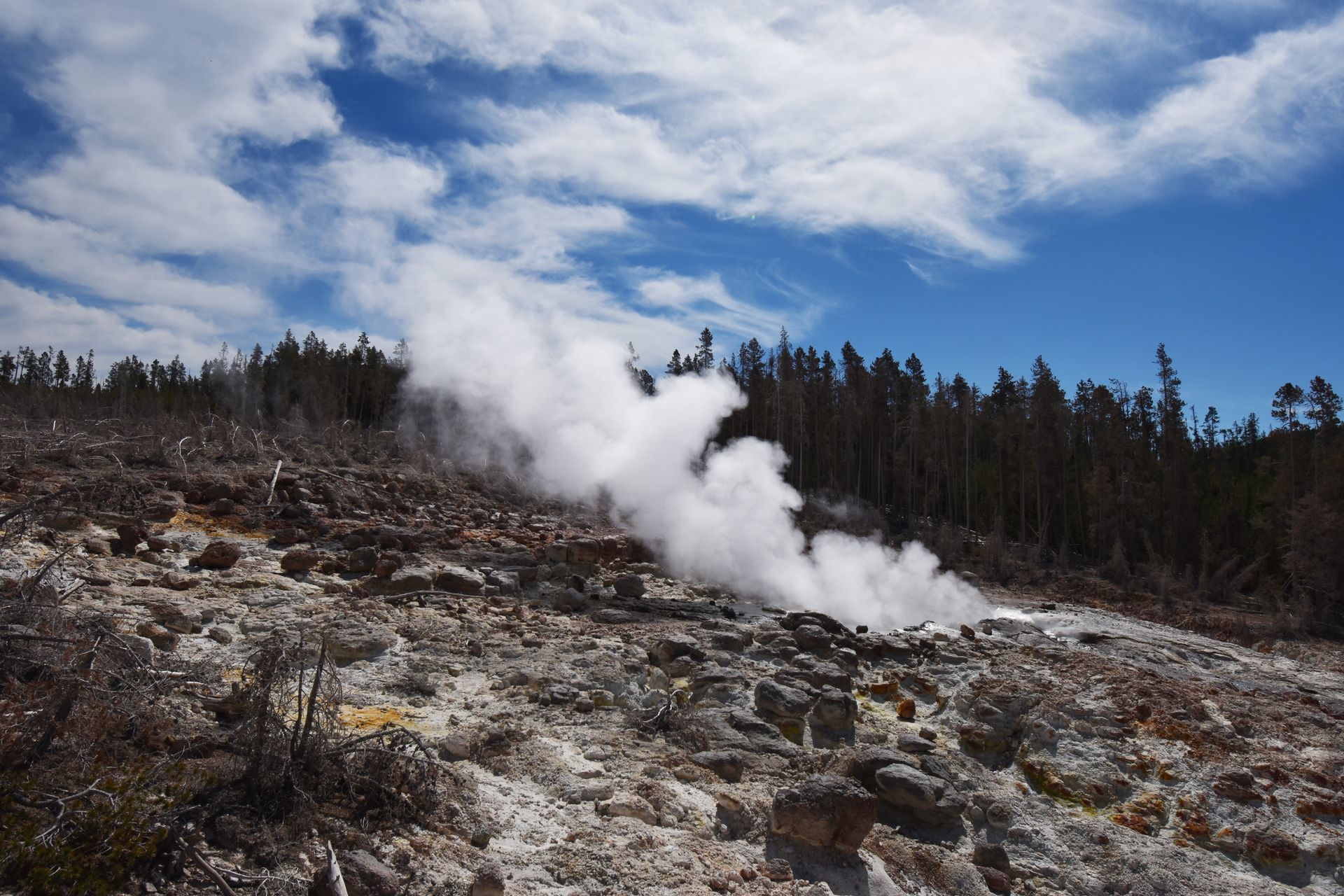
Norris Geyser Basin
The Norris Geyser Basin is a major must-see stop in Yellowstone! It is the oldest and hottest thermal area inside of the park.
There are two loop trails: the Porcelain Basin and the Back Basin. The Porcelain Basin is a short boardwalk trail that winds past large stretches of white rocks and pastel colored springs. You can also get an incredible viewpoint of this entire basin from above. The Back Basin is home to some amazing geysers inside of Yellowstone.
The most notable geyser of the area is Steamboat Geyser, the tallest active geyser in the world. The major eruptions of Steamboat are unpredictable, so it’s rare to see it go off. However, it’s fascinating to see the steam coming out and all the dead trees that surround the geyser.
For a ballpark estimate on how often Steamboat Geyser erupts, it erupted 48 times in both 2019 and 2020, but is erupting at a slower pace in 2021. It began erupting more frequently in 2018 after several years of dormancy.
At the end of the Back Basin Loop, I really enjoyed watching Vixen Geyser erupt just feet from the boardwalk. It’s known for its temperamental, spit-fire disposition and has minor eruptions often. It’s minor activity includes splashing and spouting water up to 15 feet in the air, while a rare major eruption can shoot water up to 30 feet high. It drains between eruptions and I watched the water level rise until it erupted once again.

Artist’s Paintpots
The Artist’s Paintpots are 10 minute south of the Norris Geyser Basin. They are quick to visit but one of my favorite spots! After parking, take a quick and flat half mile walk through a lodgepole forest. When you reach the paintpots, there are some giant and colorful hot springs that you can walk around. You will then ascend up a small hill to see the multicolored mud pots. The consistency may depend on recent rainfall, but you will likely see a thick pool of mud bubbling and gurgling. It looks like paint as the mud pops and splatters around the area.
Sometimes the mud bubbles enough to splatter the boardwalk! These mudpots are mesmerizing to watch.
Firehole Canyon Drive
About 15 minutes south of the Artist’s Paintpots, Firehole Drive is a quick, scenic drive that passes a 40 foot waterfall and follows along the Firehole River (which is sometimes open for swimming). The drive is one way and you’ll enter on the right when driving south. It exits back onto the Grand Loop Road, and you won’t miss anything on the main road on this little detour.
Fountain Paintpots
The Fountain Paintpots are 15 minutes south of Firehole Canyon Drive and were another favorite stop of mine. The trail here is a quick and easy boardwalk. You’ll pass the feature specifically named fountain paintpots, a large mudpot feature that bubbles at varying thicknesses depending on the time of year.
However, my favorite part was the Fountain Geyser, which I saw erupting. It gets as high as 60 feet and looks like a tall fountain as flings water up into the air. This geyser and the ones next to it were active and full of energy when I visited, making this a very memorable stop.
Firepole Lake Drive
Firepole Lake Drive is another side detour located across from Fountain Paintpots. The road will take you past several notable geysers, the most famous being the Great Fountain Geyser. I recommend checking the times ahead of time to see if you can witness the Great Fountain Geyser erupt. It erupts every 9-12 hours and can reach heights of 200 feet. It is extra special due to the cascading pools that stairstep around the feature.
Check for eruption times of the Great Fountain Geyser at the Old Faithful Visitor Center or geysertimes.org.
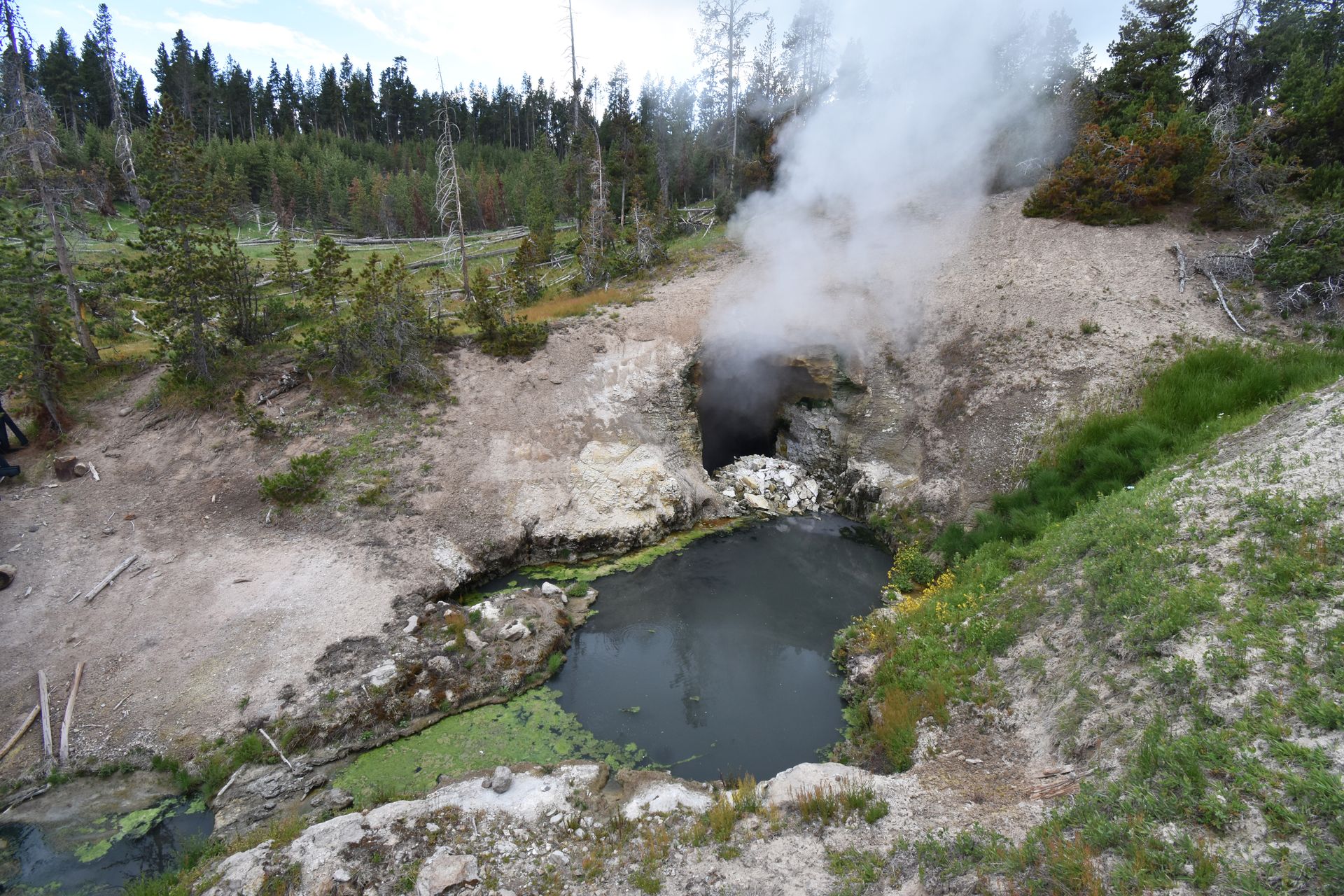
Mud Volcanoes
At this point in driving the Grand Loop, I skipped the most famous features in the park (Grand Prismatic Spring, Old Faithful, West Thumb and more), and headed around the loop towards Canyon Village, where I stayed for night two. Whether you choose to do it this way or not, you’ll want to make sure you make it over to these next few stops.
I made a quick stop to see Yellowstone Lake on the way to Mud Volcanoes! The Lake General Store is right across from the lake and a small beach. Note that the temperatures are too cold to actually swim in the lake.
My next stop was the Mud Volcanoes, which was another memorable destination. Mud Volcanoes has a boardwalk trail and short pavement trail, along with additional features across the street. The mysterious mud features found in this area are some of the most acidic in Yellowstone. The most interesting feature to me was the Dragon’s Mouth, a boiling spring that spews out steam from a mouth-like cave. Inside the cave, waves crash against the cave walls and create a roaring sound.
Across the street, there is a small parking lot with an overlook where you can gaze at more mudpot features. Interestingly, there is also a fenced area of the parking lot here where acidic features have eaten through the pavement since the parking lot was paved.
Hayden Valley
In between the Mud Volcanoes and Canyon Village, you’ll drive through Hayden Valley. This is a scenic area great for spotting wildlife. It’s most common to see bison and elk. There are several pull outs along the way where you can get a better look. Be sure to always keep a wide distance from wildlife.
Grand Canyon of the Yellowstone South Rim
The Grand Canyon of the Yellowstone has viewpoints on both the north and south rim. Since I stayed nearby in Canyon Village, I visited the south rim on the evening of day two and the north rim on the morning of day three.
There are two beautiful stops along the South Rim of the Grand Canyon of the Yellowstone. The first stop provides a great view of the Upper Falls. It is also the starting point of Uncle’s Tom Trail, but the trail was closed during all of 2020 and 2021 for renovations. It is still worth stopping here to see the view a short walk from your car.
A bit further down the road, Artist’s Point is a must-stop. From this viewpoint, there is an excellent view of the Lower Falls, the most iconic waterfall in Yellowstone. Towering at 308 feet, Lower Falls is about twice the height of Niagara Falls and flows up to 63,500 gallons per second during the spring runoff season.
This viewpoint was named Artist’s Point because many thought that the famous artist Thomas Morgan painted the Grand Canyon from here in his painting to inspire congress in 1872. It turns out his paintings were from the North Rim, but the name stuck.
Artist’s Point was my favorite viewpoint of the Grand Canyon of the Yellowstone and one of my favorite places in the entire park. We had it all to ourselves for at least 30 minutes a little before sunset!
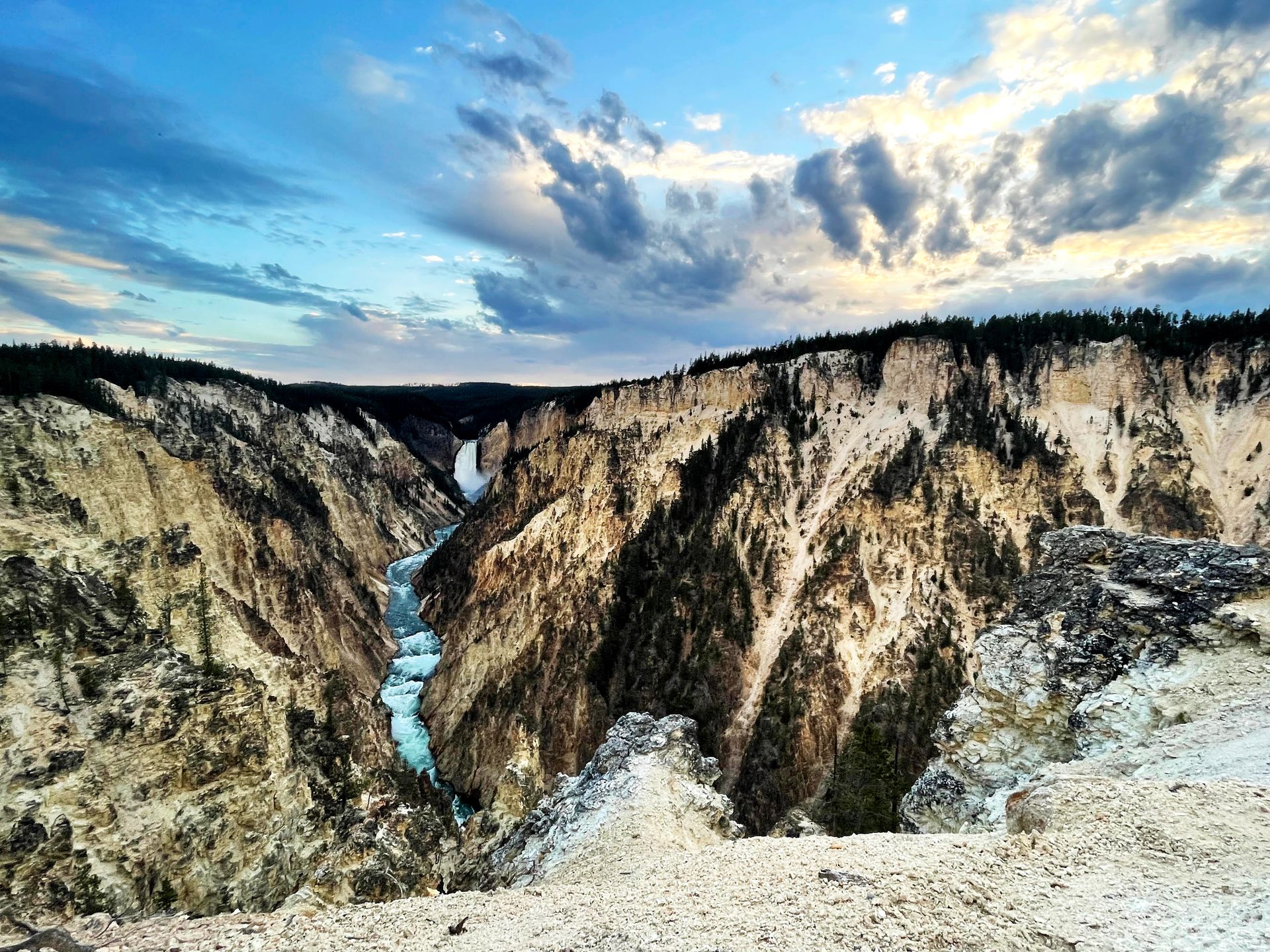
Stay at Canyon Village
Canyon Village is one of the newest lodges inside the park and claims to be the largest sustainable lodge inside of a US National Park. The village is made up of several practically identical buildings clustered in the forest just north of the canyon.
The rooms are nice and feel new, although they lacked a little bit of the charm that Mammoth Hot Springs had. A short drive or walk away, there is a visitor center, food options and shopping. I really enjoyed the fresh wok that was served in the Canyon Eatery cafeteria.
I go over all of the details about my stay in Canyon Village in my post comparing three of the lodges in Yellowstone.
If you are too late to get rooms in Canyon Village or the Old Faithful area, I recommend staying in West Yellowstone for these two nights.

Day Three in Yellowstone
Day three covers the Grand Canyon of the Yellowstone, West Thumb, Grand Prismatic Spring and Old Faithful.
Grand Canyon of the Yellowstone North Rim
If you’re staying in Canyon village, take advantage of its location and visit the Grand Canyon of the Yellowstone North Rim early to beat the crowds. There are four viewpoints on the North Rim Dr, plus one more off of the Grand Loop Road. I started on North Rim Dr and worked my way west to east (the road is one way so you’ll need to go this way).
The first stop is the Brink of the Lower Falls and it was by far my favorite. If you are willing to ascend down 600 feet on a series of paved switchbacks, you’ll be right above the powerful Lower Falls.
As you walk up to the fence, you can feel the mist of the waterfall and will have an amazing view of the pink and orange canyon in front of you. The hike is steep so keep in mind that if you go down, you’ll have to come back up. Make sure you’re in good condition and prepared with water to attempt this, but it is completely worth the climb.
After the Brink of the Lower Falls, the next stop is Lookout Point. To reach the lower viewpoint, you’ll ascend down 500 feet for a great view of Lower Falls. This is the clearest view of the Lower Falls from the North Rim. This trail is definitely worth doing if you have time. However, if you only choose to do one, I would recommend the Brink of the Lower Falls instead.
Next along the North Rim Road, you’ll reach Grand View. This is a viewpoint where the river is the focal point and you can see the Yellowstone River snake back and forth deep in the canyon. It’s a quick stop and a short walk from your car.
Finally, the last viewpoint on this road is Inspiration Point. This overlook provides a view of the river-carved canyon looking in both directions. If you’d like to stick around longer and do some hiking in and around the Grand Canyon of the Yellowstone, there is a trailhead halfway down the road to Inspiration Point. Here you can hike to a viewpoint of Silver Cord Cascade falls (a tall and skinny waterfall) and continue on the Seven Mile Hole Trail to hike down into the Grand Canyon.
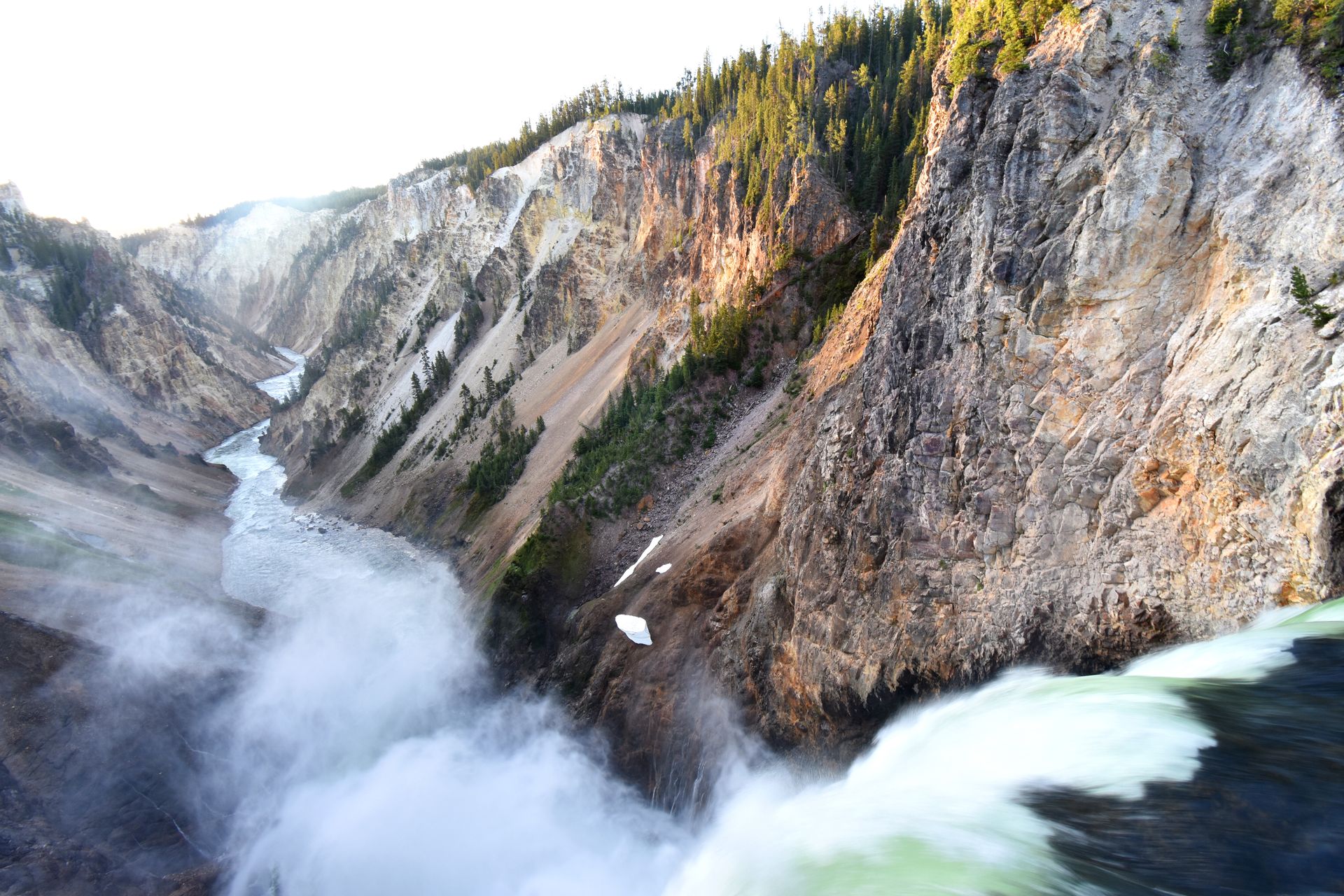
Grand Canyon of the Yellowstone Brink of the Upper Falls
During my visit, I did the four stops above as early as possible, and then we returned to Canyon Village to check out and have breakfast. When we were ready to leave, we began heading back south on the Grand Loop Rd and made one last Grand Canyon stop at the Brink of the Upper Falls.
This path to this viewpoint is much shorter than the Lower Falls and has barely any elevation change. It’s not as impressive as the Lower Falls, but still incredible to get up right next to the waterfall and watch the water flowing through the canyon.
West Thumb
Make your way back south on the Grand Loop towards more incredible thermal features. If you missed the Mud Volcanoes the day before, be sure to stop there first. The West Thumb Geyser Basin is located on the banks of Lake Yellowstone, a little less than an hour from Canyon Village.
The trail at West Thumb is a mile on a boardwalk and will take you past several geysers and hot springs. Most notable is the Fishing Cone, a cone shaped hot spring located in the lake. In the late 1800’s, fishermen would stand on the cone while fishing in the lake, and then cook the fish in the heated water of the spring. Depending on the lake’s water level, the cone shape may not be visible.
All of the hot springs here are beautiful and felt very really unique to witness the features right next to the large lake.
You cannot swim in Yellowstone Lake, but you can kayak! A kayaking tour is a great option to learn about the largest high elevation lake in North America if you have extra time.

Grand Prismatic Spring
At this point in the itinerary you’ll visit the most popular and crowded destinations in the park. I enjoyed saving the “best” for last because I had already gained such an appreciation for the amazing thermal features throughout the park. At this point, it will likely be in the middle of the day. Parking fills up here, but I was able to find a spot with just a little patience.
The Grand Prismatic Spring is famous for good reason - it is larger than a football field, deeper than a 10 story building and shows the whole rainbow of colors. The colors will be most vibrant on a sunny and clear day (It was unfortunately raining when I visited). To visit, you’ll walk along a short boardwalk trail and pass a couple of other large springs before you reach Grand Prismatic. It’s very cool to see the spring up close, but the best view is to see the spring from above.
Grand Prismatic Spring Overlook
To get a bird’s eye view overlooking the Grand Prismatic Spring, drive about 5 minutes down the road to a new parking lot. The hike to reach the overlook is 1.6 miles round trip with 200 feet in elevation change. You’ll gain a deep appreciation of the sheer size of the spring from above, it’s certainly worth the effort. If you have more time, you can continue from this trail and hike to Fairy Falls and the Imperial Geyser.

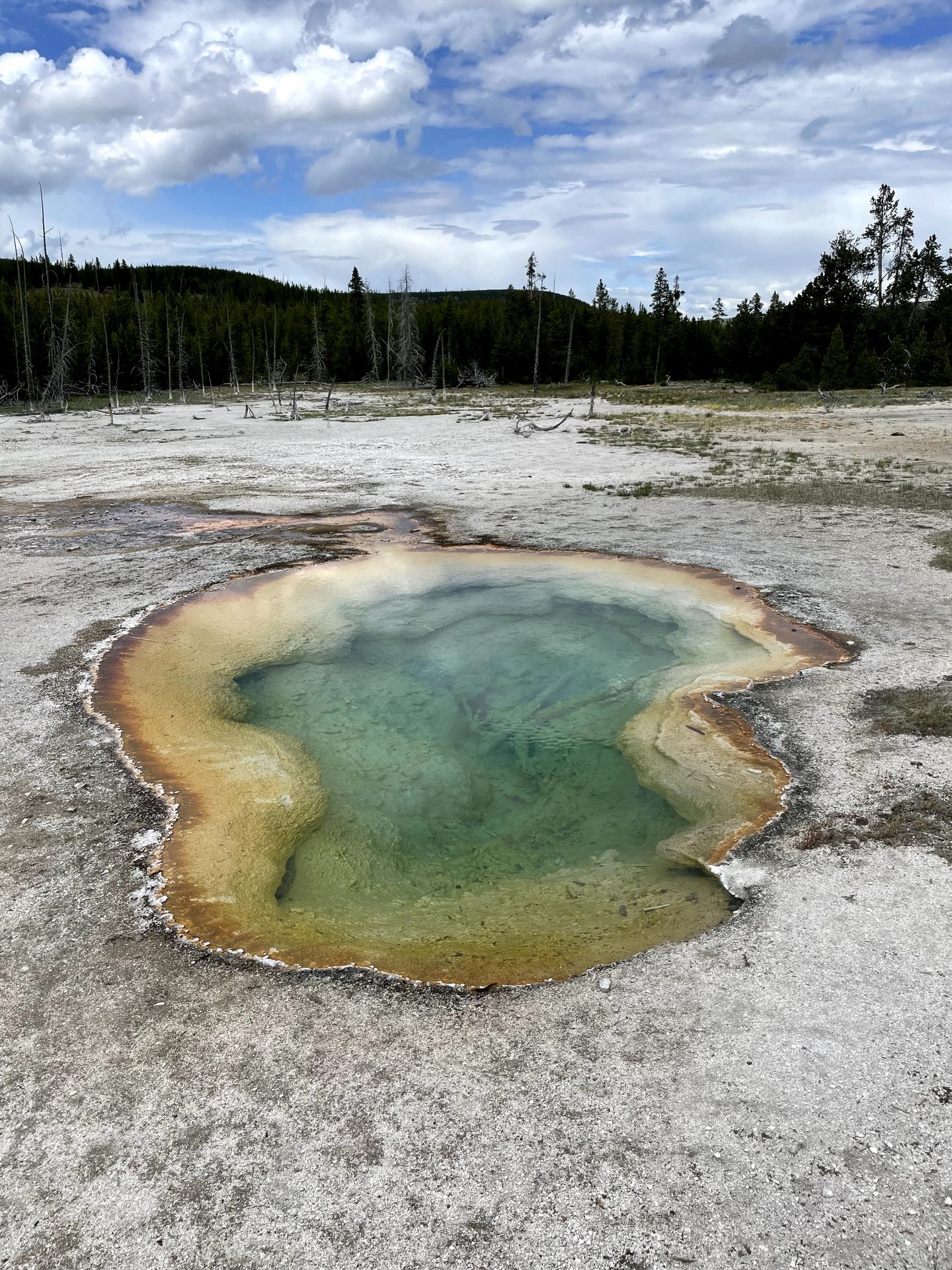
Biscuit Basin
As of July 2024, Biscuit Basin is closed due an explosion caused by water steam.
Biscuit Basin is located between the Grand Prismatic Spring and the Upper Geyser Basin (the Upper Geyser Basin is also home to Old Faithful). This small 0.7 mile boardwalk loop is known for its gem-like pools. You have the opportunity to see geysers that go off quite often, such as Jewel Geyser and Avoca Springs. In addition to the geyser, Sapphire Pool is a beautiful pool colored deep blue. You can also walk between here and Old Faithful while exploring the Upper Geyser Basin.
Old Faithful
Finally, make your way to the most famous feature in Yellowstone, Old Faithful! This geyser is famous for its consistency - it faithfully erupts about every 90 minutes and has an average height of 130-140 feet tall. As soon as you arrive, look for signs at the buildings to see what time Old Faithful will erupt next. There is stadium style seating surrounding the geyser on a boardwalk. You can also watch it erupt from a higher viewpoint at Observation Point.
Arrive 30 minutes before Old Faithful is expected to erupt to get a good seat on the boardwalk!
This entire area was built around Old Faithful. You can also watch the geyser erupt from the deck of the Old Faithful Lodge or the balcony of the Old Faithful Inn. I recommend spending enough time here to watch the geyser erupt a few times from different areas.
I had dinner at the Old Faithful Lodge cafeteria. It was similar to the Canyon Village cafeteria, but not nearly as fresh. The Snow Lodge nearby has a restaurant that is a lot nicer.
Upper Geyser Basin
Right next to Old Faithful, there are many more hot springs and geysers to see. This area contains the largest concentration of geysers in the world! Walk from Old Faithful and explore as much of the area as you have time. Some notable geysers have predicted times posted at the visitor center. See if you can time your visit see eruptions of Castle Geyser (castle shaped and every 12-14 hours), Daisy Geyser (every 2-3 hours), Riverside Geyser (every 6-7 hours) or Grand Geyser (every 6-7 hours and taller than Old Faithful).
If you explore the entire Upper Geyser area by foot, it will be about 5 miles. This was an amazing spot to explore around sunset, because the crowds had cleared by then.
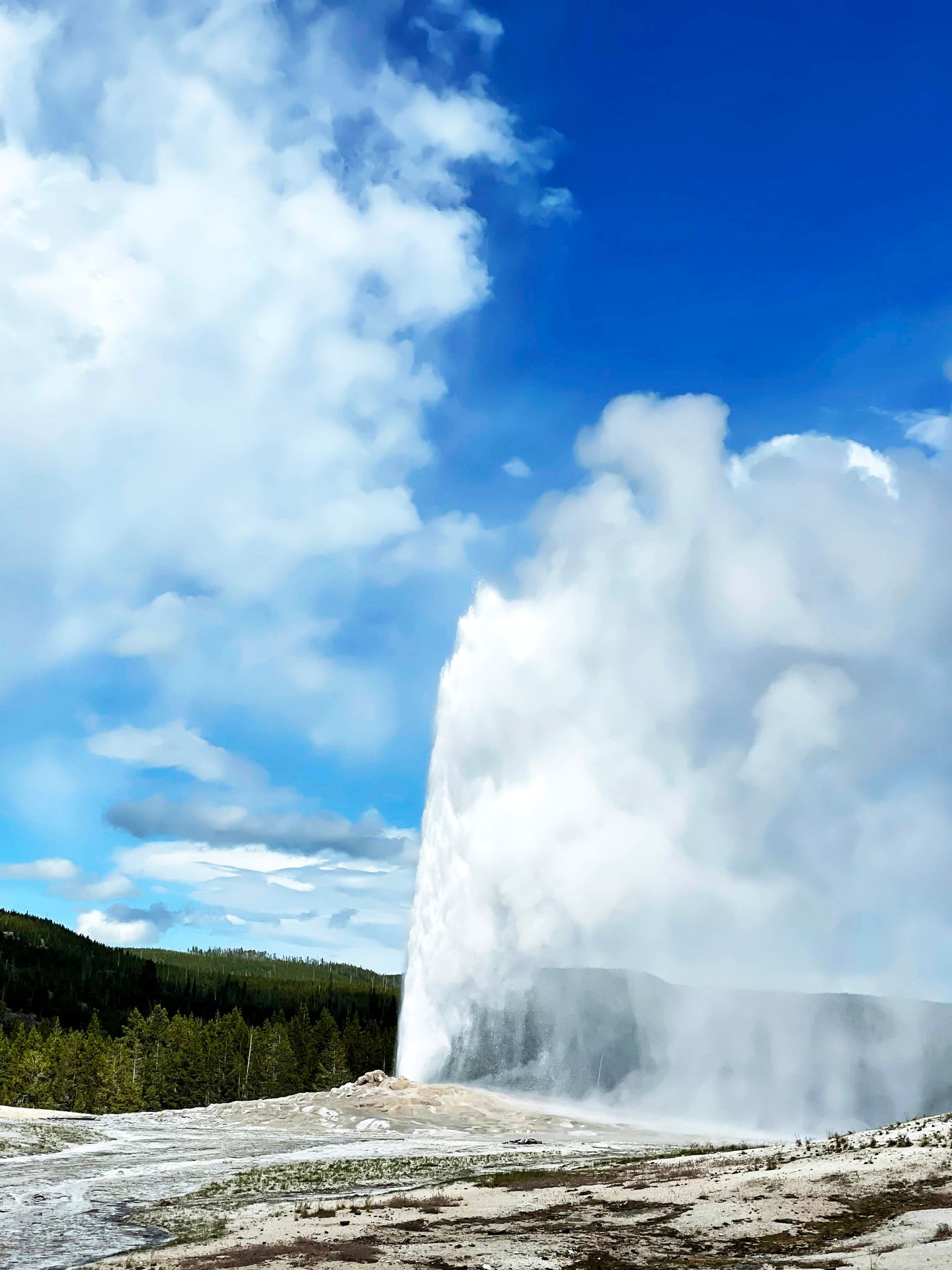

Stay at Old Faithful Inn
Check into the Old Faithful Inn, Snow Lodge or Old Faithful Lodge for the night. If you aren’t staying in the Old Faithful Inn, be sure to at least walk inside and look up at the log cabin architecture inside the unique and historic building.
I stayed in the West Wing of the Old Faithful Inn and have to admit it was the lowest quality room out of my three nights in the park. If you want the full Old Faithful Inn experience, book an “Old House” room to be connected to the historic lobby (these rooms do not have private bathrooms). If the Old House rooms are taken, I’d recommend a room in the Snow Lodge over a room in the wings of Old Faithful Inn.
I enjoyed a huckleberry margarita from the bar on the second level of Old Faithful Inn. You can sit outside on the balcony and watch Old Faithful erupt with a drink in hand!
Read more about my full experience staying in the Old Faithful Inn in my lodge comparison post!
Day Four - Leaving Yellowstone
After waking up in the Old Faithful area, check the geyser eruption times and visit anything in the area you might have missed. From here, I made my way south and spent two days in Grand Teton National Park before flying out of Jackson. The drive time between Old Faithful and the beginning of Grand Teton is a little over an hour. To read my full guide on visiting Grand Teton, check out my blog post!
I hope you find this guide helpful for planning a trip to Yellowstone! If you have any questions, don’t hesitate to reach out to lydia@lostwithlydia.com or contact me via Instagram DM. Happy Planning!
Final Thoughts
America's first national park should be on everyone's USA bucket list! I hope this guide helps you plan an epic trip to Yellowstone National Park and plan an itinerary to maximize your time.
For more US national park travel guides, check out these blogs:
- The Ultimate Yellowstone Packing List
- How to Spend 2 Days in Grand Teton National Park
- The Ultimate Guide to Visiting Glacier National Park
- How to Spend 2 Days in Zion National Park
- How to Spend 2 Days in Channel Islands National Park
- How to Spend 1 Day in Theodore Roosevelt National Park
- How to Spend 2 Days in Rocky Mountain National Park
- The Best Things To Do in Cuyahoga Valley National Park
- The Best Hiking Trails in Acadia National Park
Thanks for Reading!
Let's stay in touch!
Join the Lost with Lydia email list to get monthly travel guides and tips!
